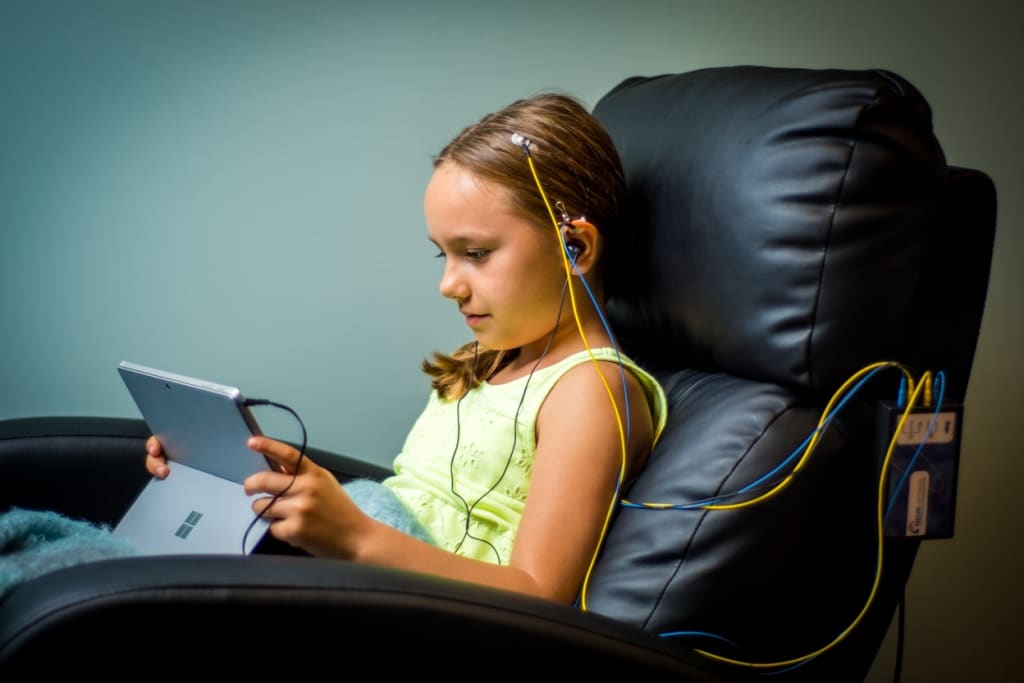Neurofeedback Playroom: Helping Children with Autism and ADHD
Neurofeedback therapy is a state-of-the-art treatment method that uses biofeedback.

In simple words, it is like fitness for the brain. This distinctive method has been developed through advancements in computer analysis technologies and enables the visualization of various physiological processes for targeted intervention. It's important to highlight that, from the patient's perspective, this training turns into an engaging computer game. Due to the malleability of children's brains, this approach proves to be particularly effective in addressing behavioral and mental disorders that children have.
What is neurofeedback technology?
Neurofeedback technology is a sophisticated form of drug-free therapy in which people, including children, learn to consciously control involuntary physiological processes and organ functions. These processes include:
- muscle tension
- blood pressure
- heart rate
The neurofeedback method is entirely safe for children, as the hardware used does not exert any direct effects on the body; rather, it solely gathers data on physiological parameters. The practice of biofeedback therapy is largely free from contraindications, and it lacks associated side effects and complications. Starting from around the age of 5-6 (dependent on the level of individual mental development), children can undergo a course of biofeedback therapy.
Biofeedback sessions are used to both prevent and treat a variety of conditions, including:
- headaches and migraines
- chronic pain syndrome
- hypertension
- posture disorders
- obsessive-compulsive disorders
- hypermobility syndrome
- attention deficits
- panic attacks
- Inattention
Biofeedback therapy proves effective in addressing numerous issues faced by children, such as poor adaptation to stress in kindergarten or school, impaired attention, sleep disturbances, fears and anxieties, irritability and capriciousness, persistent low mood, lack of energy, tics, and stuttering. We will examine this method for behavior correction in children with autism and ADHD.
Biofeedback Therapy for Children with ADHD
One of the most evident symptoms of ADHD (Attention Deficit Hyperactivity Disorder) is a child's difficulty in self-regulating their behavior and maintaining attention on any given activity for a substantial period of time.
Specialists have observed a recent increase in the number of children diagnosed with ADHD. This emphasizes the significance of addressing effective correction methods for this condition. Although hyperactivity and attention deficit disorder are not classified as mental disorders, their repercussions can result in notable challenges for the child, particularly during the preschool and primary school years.
EEG Biofeedback devices encompass specialized computer programs that, through analyzing the responses of a hyperactive child, instruct them in managing their activity and behavior. Additionally, these devices aid in honing cognitive abilities by providing feedback in the form of a video game: comprehensible and visual imagery throughout the session. In essence, the sessions are designed to be enjoyable and straightforward for the child.
The presence of an imbalance between the theta waves and beta waves in the right frontal and prefrontal areas of the cortex in children with ADHD enables the utilization of BFB (Biofeedback) based on the amplitude-frequency characteristics of the EEG. This approach highlights the power of the respective rhythms and facilitates their directional modification.
The Efficacy of Neurofeedback Sessions for a Child with ADHD
During the session the child gets:
- the opportunity to learn how to manage their own activity;
- a chance to improve the main characteristics of attention: switchability, stability, and others;
- the ability to control their own physiological reactions.
Biofeedback sessions offer several benefits for a child with ADHD, including:
1. Skill in Activity Management
They provide the child with the opportunity to learn how to self regulate and control their own activity levels.
2. Enhancement of Attention
These sessions contribute to the improvement of key attention-related traits, such as the ability to switch focus and sustain stability in attention.
3. Control over Physiological Reactions
Biofeedback empowers the child to manage their own physiological responses, aiding in the reduction of hyperactivity and impulsivity associated with ADHD.
Based on numerous studies, biofeedback therapy for correcting ADHD symptoms offers more than just the opportunity to develop specific traits. It also leads to improvements in academic performance, cultivates self-control, and fosters emotional and volitional regulation within the child. In essence, biofeedback therapy proves to be a holistic approach with wide-ranging positive effects.
The outcome of a Neurofeedback treatment course extends to the harmonization of the child's entire environment. It shows significant improvement in the child’s behaviour and self-perception. Hyperactivity presents a significant challenge not only for the child but also for parents, educators, and teachers. It not only hinders the child's acquisition of essential knowledge and skills, crucial for learning, but also gives rise to unregulated movement and activity. This, in turn, necessitates various forms of educational intervention for the child, occasionally taking a stern approach, particularly when parents feel overwhelmed and fatigued.
The Efficacy of Biofeedback Sessions for a Child with Autism Spectrum Disorder
Biofeedback techniques (BFB) have emerged as a promising avenue for addressing the developmental challenges faced by children with Autism Spectrum Disorder (ASD). Over the past few decades, EEG-based brain training has gained traction as a non-invasive treatment approach for diverse pediatric populations diagnosed with neuropsychiatric disorders.
This control is established through the provision of real-time visual feedback to the patient. Simultaneously, the desired adjustments in electrophysiological parameters are attained by utilizing visual and auditory cues that function as rewards within the task's context. The viability of employing BFB as a treatment method hinges on the identification of abnormal electrophysiological activity within the patient. Throughout the course of treatment, patients work towards normalizing this irregular activity, progressively aligning their readings with values characteristic of typically developing children.
EEG activity in children with ASD diverges from the norm in various parameters, including:
- an elevated high-frequency component
- diminished mu-rhythm reactivity
- disrupted functional connectivity
Strategies to Correct Brain Wave Patterns through Neurotherapy
Currently, several strategies (protocols) have been formulated for the application of BFB in addressing the developmental needs of children with ASD. A primary distinction among these protocols lies in the assortment of EEG parameters targeted for modification through neurofeedback training.
One of the particularly promising avenues of research focuses on training mu-rhythm modulation using biofeedback. This neurotherapy protocol is intriguing due to its potential impact on the Mirror Neuron System (MNS), which is hypothesized to be linked with autism development.
Another noteworthy distinction among various biofeedback therapy approaches pertains to the type of positive feedback employed. Currently, the prevalent training methods involve altering the size or speed of moving objects on a computer monitor, corresponding to specific changes in EEG indicators, providing visual feedback to the child.
These straightforward parameters do not demand a complex comprehension of the process, rendering them accessible to children even at a young age – a notable advantage. This approach to training can also encompass highly effective musical interventions, wherein the volume of music is contingent upon EEG parameters. Comparatively rare are more intricate games, some of which incorporate elements of social interaction. Given that the primary challenges in children with ASD revolve around social communication, this approach holds an additional beneficial impact.
How Telemedicine can Help in Delivering Neurofeedback Sessions
Telemedicine can play a significant role in delivering neurofeedback therapy to kids, especially in situations where in-person sessions might be challenging or not feasible. Here's how telemedicine can help:
1. Remote Access
Telemedicine allows children to receive neurofeedback therapy from the comfort of their own homes. This is particularly beneficial for kids who might have difficulty traveling due to their condition, scheduling conflicts, or other limitations.
2. Convenience
Telemedicine eliminates the need for families to travel to a clinic, saving time and effort. Parents and children can participate in sessions without the stress of commuting.
3. Consistency
Regular sessions are essential for effective neurofeedback therapy. Telemedicine ensures that children can attend sessions consistently, even if they are unable to physically visit a clinic.
4. Personalized Care
Therapists can still provide individualized treatment plans through telemedicine. They can assess the child's progress, adjust protocols, and provide tailored feedback remotely.
5. Data Collection
Biofeedback and neurofeedback systems can often transmit data remotely. This allows therapists to monitor the child's physiological responses during sessions, ensuring that they are on track and making progress.
6. Engagement
Telemedicine platforms can be designed to engage children through interactive interfaces, making sessions more appealing and interactive, which is especially important for younger kids.
7. Recorded Sessions
Telemedicine sessions can be recorded for review, allowing therapists to analyze the child's responses more comprehensively and make informed adjustments to the treatment plan.
8. Progress Tracking
Therapists can monitor progress over time using remote communication tools and data analytics, ensuring that the therapy is effective and making necessary adaptations.
It's important to note that while telemedicine offers numerous benefits, it might not be suitable for all cases. Some children might require in-person sessions, especially in complex cases that demand close physical observation and interaction. It's advisable to consult with medical professionals to determine the most suitable approach for each child's needs.
Conclusions
Overall improvement of mental health is one of the most important effects of neurofeedback treatment. The method enables both the doctor and the patient to optimize the body's normal physiological functions. This is achieved through specialized processing of information concerning the functioning of its internal organs and systems. This processing relies on data derived from the evidence-based data: bioelectrical activity of the brain, heart, various muscles, and respiratory organs, along with other indicators that are collected through diagnostic sensors.
About the Creator
Natalia Zheleznaya
SEO Outreach specialist at Medesk






Comments (1)
great work why cant you join my friends and read what I have just prepared for you